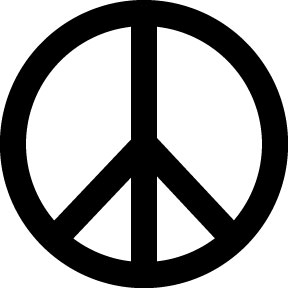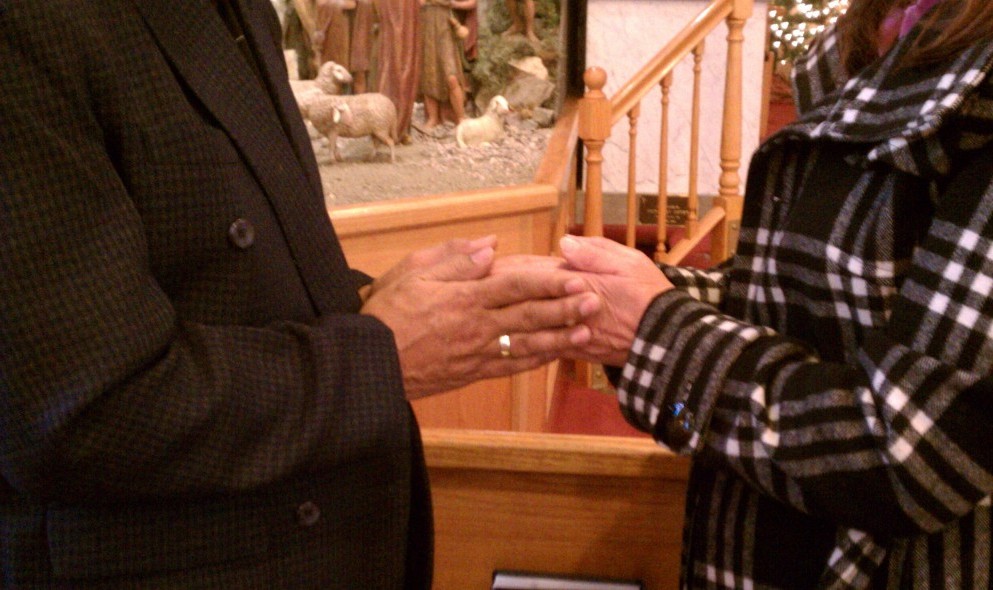Peace, but not as the world gives…
 I didn’t want to let another week pass without commenting on a blog entry entitled The Sign of Peace – theory and practice by my favourite Australian monk over at Dominus Mihi Adjutor.
I didn’t want to let another week pass without commenting on a blog entry entitled The Sign of Peace – theory and practice by my favourite Australian monk over at Dominus Mihi Adjutor.
He opens the blog entry describing some of the awkwardness that routinely arises at the“Sign of Peace” in a typical parish.
For those unfamiliar with this moment of the Mass, it is when members of the congregation are encouraged to give “a sign of peace” to one another, usually in the form of a handshake, or sometimes a kiss or hug for family members or close friends. This takes place shortly before receiving communion, with the priest saying:
Priest: Lord Jesus Christ, you said to your apostles: “I leave you peace, my peace I give you”. Look not on our sins, but on the faith of your Church, and grant us the peace and unity of your kingdom where you live for ever and ever.
All: Amen.
Priest: The Peace of the Lord be with you always.
All: And also with you.
Deacon or Priest: Let us offer each other a sign of peace…
[Sign of Peace]
All: Lamb of God who takes away the sins of the world, have mercy on us…
As Fr. Hugh mentions, the Sign of Peace is actually an optional part of the Mass and I quite often go to a Mass here in San Diego where the priest omits it entirely which some people love and others hate. The Byzantine Rite parish I visit whenever I can has no general Sign of Peace.
Fr. Hugh traces the development of the Sign of Peace from New Testament times through the early centuries and into the modern Church. He argues that the Sign of Peace which takes place in most parishes today doesn’t really fulfill its intended liturgical purpose and is often more of a disturbance than anything else.
Our Survey Said..
I’ve traveled quite a bit in recent years and visited many, many different parishes, both in England and here in the United States. On the whole, I think I would have to agree with Fr. Hugh’s assessment of the situation.
The Sign of Peace can vary quite considerably from parish to parish. Some priests only give you just enough time to shake the hand of your immediate neighbours, whereas other priests set aside a larger portion of time so as to encourage parishioners to share the Sign of Peace with those further afield.
On the whole, most people exchange the Peace with a handshake. In recent years, I have noticed an increase in people who seem unwilling to shake hands. It has been my guess that this is mostly to do with “germophobia”.
Now, there are certainly legitimate reasons for not wanting to shake hands – if you have “The Plague”, then I’m very grateful for your unwillingness to pass it on to me! I think every Catholic has had at least one experience where they’ve sat next to someone who coughed their entire way through Mass, but then at the Sign of Peace presented the hand into which they had been coughing throughout! Yuck!
However, even though legitimate reasons for not wanting to shake hands exist, it really does put a bit of dampener on the whole proceedings if someone is reticent or outright refuses to shake your hand. I’ll admit it is sometimes a bit hard not to take such things personally, even if it’s not intended.
The style of the handshake itself can also vary dramatically. Some people give a very weak handshake, but after shaking the hand of some others I’ve felt the need to stop by the hospital on the way home to get a quick x-ray and check my hand for bone damage.
There is also the dilemma as to what to do about those who are far away from your seat. If it is not possible to easily reach these people, parishioners will often give a little bow, smile or wave. There is also the predominantly American practice of holding up two fingers and give the “peace” sign:
This disturbs my English sensibilities. Bunch of hippies… 😉
I have been part of small parishes where everyone knew each other and a longer period of time and the more intimate signs of peace seemed more fitting. However, in the larger parishes I’ve visited, when they have attempted this it usually descends into chaos fairly quickly and people are still busy wandering around the church even after the “Lamb of God” has concluded.
The Maronite Solution
Personally, I think the Maronite Rite‘s liturgy has the answer to virtually all these problems. When I visited a Maronite parish in London I saw the way they did the Sign of Peace and thought it was pretty much perfect.
The altar servers comes up to the presiding priest with their hands together in the posture of prayer. Facing each server in turn, the priest then brings his hands together around each set of hands and offers each server peace.
The servers then descend from the altar and move down the central aisle, offering the sign of peace to those at the end of the pews. These parishioners then turn and offer the peace in the same way to their immediate neighbour who, afterwards, does the same. Thus the peace is propagated throughout the congregation.
As well as providing a beautiful visual effect, this makes a profound statement about the peace which we receive from the altar and which connects us all. I think this is a beautiful, solemn, gentle and heartfelt sign of peace and I think it would be wonderful if this practice were adopted by Catholics belonging to non-Maronite churches.
Until the reign of Pope David…
However, until such a day when the Cardinals see fit to elevate me to the Chair of St. Peter, I imagine the Sign of Peace will remain in its current state in most Catholic parishes. So until then, I would like to simply offer my favourite observation from Fr. Hugh’s blog entry:
“There is something incestuous about offering the Peace only to family and friends. If it is to be offered, surely it should be offered to those we do not know, the stranger in our midst, the fellow Christian with whom we are at peace in Christ despite our not knowing him or her” – Fr. Hugh
So, go on, hug a stranger… 😉



How kind of you to take up my thread on the Sign of Peace! Obviously you make good sense, especially in those spots where you agree with me. But I did raise an eyebrow when you wrote,
For me there is no dilemma. One should not be worrying about people nowhere near one – one gives the sign to those in the immediate vicinity, whomever they might be, and then eyes straight back to the altar, and mouth on the Agnus Dei. That is, if one must have the sign of peace.
Pax!